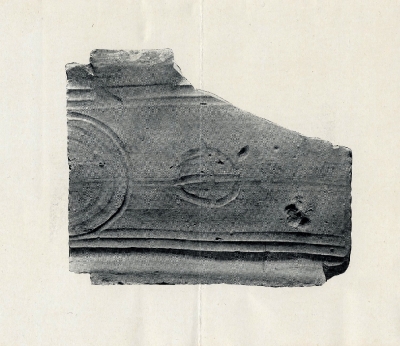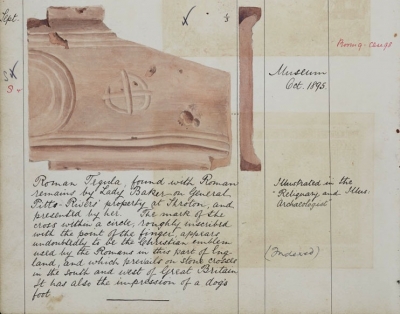S&SWM PR papers L1418
L1409
Ansd Sept. 30/95
The Reliquary and Illustrated Archaeologist | 28 Gt Ormond St London W.C. | Sept 28 1895
Dear General Pitt-Rivers
I beg to thank you for the photograph of the Roman tile from Iwerne which is of such unique interest that I should certainly be glad to have your kind permission to publish it in the "Reliquary". The publication of an an [sic] illustration of the tile might elicit other opinions more valuable than my own. I think the cross within the circle on this tile has certainly a good claim to be considered [insert] one of the earliest [end insert] Christian symbols yet found in Great Britain. It would be quite impossible for anyone to prove that it was not a Christian symbol. The only question is whether it was intended for the Pagan wheel symbol, which although chiefly characteristic of the Bronze Age in Scandinavia, is I believe to be seen on one or two Roman altars in the north of England. One would expect to find the Chi-Rho monogram used in preference to the circular cross during the Romano-British period, but at the same time the [Drawing] occurs on the earliest post-Roman monuments in this country and may very well have been a recognized Christian symbol in the 4th or 5th century. On the whole I consider the probability is in favour of the Iwerne tile being Christian, but I should like to hear what some specialist in Roman things has to say about it.
I believe we have found the tombstone of Gilda's old sinner Vortipore. If so he has a very early cross of this shape [drawing] above his epitaph. This is illustrated in the October no. of the "Reliquary".
I remain
yrs. vy. sincerely
J Romilly Allen
--------------------
L1418
The Reliquary and Illustrated Archaeologist | 28 Gt Ormond St London W.C. | Oct 23 1895
Dear General Pitt-Rivers
I enclose proof of block of Roman tile with cross upon it. If you can spare time to write a short note about it I shall be very much obliged.
I have been lately going into the question of the spiral ornament of the Irish mss. and the art of the "Late-Celtic" period, and there are some remarkable [insert] circular [end insert] enamelled discs which seem to afford a connecting link between the two styles. I believe you have one in your collection which was found near Oxford. I should be glad to know if you have any particulars with regard to the circumstances under which it was found.
Mr C.H. Read says he thinks they are late Saxon, but does not seem to have any theory as to what these discs were used for. I think the subject would be worth investigating so as to settle their date.
I remain
yrs vy truly
J Romilly Allen
Enclosure [printed label to go with photograph shown on this page and also enclosed]
Roman tegula, found with Roman Remains by Lady Baker on General Pitt-Rivers's property at Shroton, and presented by her. The mark of the cross within a circle, roughly inscribed with the point of the finger, appears undoubtedly to be the Christian emblem used by the Romans in this part of England, and which prevails on stone crosses in the south and west of Great Britain. It has also the impression of a dog's foot.
----------------
L1532
Ansd. Mar. 24/96
The Reliquary and Illustrated Archaeologist | 28 Gt Ormond St London W.C. | Mar. 14 1895
Dear General Pitt-Rivers
I am much obliged for the proof of your note on the cross marked tile from Iwerne and also for the drawing of the circular metal disc with enamelled spiral ornament. I was in hopes that some particulars might have been preserved as to the circumstances under which the disc in your possession was found. There are one or two similar discs in the British Museum, but they are placed in the Saxon Room and not with the "Late Celtic" metalwork, I asked Mr Read why they were classed with the Saxon things and he was unable to give any satisfactory reason based on the objects found in association with them. Dr Sophus Müller thinks these discs were used as the mountings of metal bowls with peculiar hook-shaped handles and he has written an article on the subject in the "Memoires de la Sociéte des Antiquaires du Nord". One of the discs, found near the Topsway, I think, or in Derbyshire, has a hook still attached to it. The disc would be fixed to the bowl and the hook would serve as a handle. A hook of this kind is illustrated by Dr Sophus Müller but the [insert] enamelled [end insert] part attached to the bowl is not circular but like this [drawing] The ornament is, however, of the same kind as on the circular discs. I think that English antiquaries have had an idea that these discs were used as pendants
I remain
yrs vy truly
JRomilly Allen
The tegula is Add.9455vol3_p1214 /2, the enamelled disc is probably Add.9455vol2_p18 /5 described as 'Antiquities purchased at Sale at Christie’s May 8 1884 and following days formerly in the Collection of the late Lord Londesborough] ... Lot 291 A circular Pendant of Copper, with spiral ornaments enamelled in colours. British [Drawing] Bought by Mr Roach Smith from a person who procured it in the vicinity of Oxford A.W.F.' Pitt-Rivers' article was 'On a Roman tile marked with a cross found at Iwerne, Dorset' Reliquary and Illustrated Archaeologist 2 (1896) 111-2
Transcribed for Rethinking Pitt-Rivers project by AP June 2011




